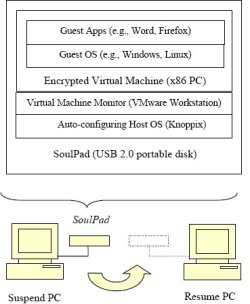IBM decouples PC “souls” from “bodies”
Aug 16, 2005 — by LinuxDevices Staff — from the LinuxDevices Archive — 1 viewsIBM researchers have prototyped a personal computing paradigm they believe could “change the way computers are built and used.” The SoulPad Project aims to decouple computer “bodies” (CPUs, I/O devices, etc.) and computing “souls” (OSes and applications), allowing users to transport souls on mobile devices such as cell phones, iPods, and USB storage devices.
The SoulPad Project has developed a prototypical three-layer software stack comprising a host OS, virtual machine monitor, and user session layers. The stack allows users to hibernate their computing sessions onto a pocket form-factor device (e.g. a portable USB hard drive), for later resumption on a completely different PC.

The SoulPad comprises host OS, VMM, and user session layers
The SoulPad's host OS layer is based on Knoppix, a small “live” Linux distribution capable of detecting and self-configuring itself at boot time to accommodate a wide variety of x86 hardware. In the SoulPad prototype, Knoppix is used as a kind of bootloader that initializes and boots the PC, and manages security. The user must supply a secret password — optionally by inserting a USB dongle — midway through the Knoppix boot, in order to access an encrypted filesystem containing their personal computing environment.
After Knoppix mounts the encrypted filesystem and finishes booting, it launches a virtual machine monitor layer that serves as a platform from which the user's chosen operating system (OS) loads. In the SoulPad prototype, this layer is based on VMware Workstation, a commercial software package that virtualizes a PC's hardware resources, allowing multiple OSes to run concurrently. SoulPad users can choose to run Linux, Windows, or other OSes supported by VMware as the OS platform (the “Guest OS”) for their application software.
OS sessions within VMWare can be suspended to disk, a capability exploited by the SoulPad software stack to prevent having to relaunch the user's OS and applications each time.
Launching the complete SoulPad software stack currently takes about two and a half minutes, including booting Knoppix, launching VMWare, and restoring the user's OS, session state, and running applications from the encrypted filesystem. Hibernating the session back onto a portable storage device takes about 30 seconds, according to IBM.
IBM has published a video, available in low and high resolutions, showing a user resuming a session stored on an iPod Photo equipped with a 60GB harddrive, to demonstrate that the SoulPad software stack can be added to devices with 6GB or more of storage. The session boots up, and shows a game of chess in progress, a document being edited in a word processor, and a music player playing a pop tune.
The SoulPad project believes its approach to be superior to similar projects such as Intel's wireless Personal Server project (stories here and here) and the Internet Suspend and Resume project. Compared to the former, the SoulPad eliminates wireless device association and power requirements. In contrast to both, the SoulPad requires no particular software stack on the client computer.
The SoulPad project hopes its technology will be useful to itinerant business professionals, as well as users in developing nations who cannot afford a complete PC, yet wish to maintain personalized computing environments.
The SoulPad project hopes its technology will be useful to itinerant business professionals, as well as users in developing nations who cannot afford a complete PC, yet wish to maintain personalized computing environments.
The SoulPad project team consists of M. T. Raghunath, Chandra Narayanaswami, Ramón Cáceres, and Casey Carter (summer intern – 2004). Long-time LinuxDevices.com readers may remember Narayanaswami and Raghunath, for their involvement in the Linux wrist watch project, one of the first applications of Bluetooth technology.
The SoulPad project team has published a 14-page paper describing how boot and suspend times vary according to processor, disk, and interconnect speed; runtime overhead caused by virtualization; practical issues related to processor architecture evolution; and various security issues. The complete SoulPad paper can be found here.
This article was originally published on LinuxDevices.com and has been donated to the open source community by QuinStreet Inc. Please visit LinuxToday.com for up-to-date news and articles about Linux and open source.